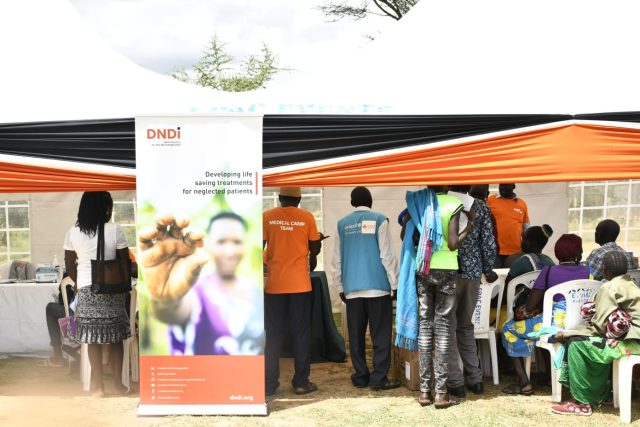Hundreds of residents in dry arid areas of West Pokot County have benefited from a free medical camp on ailments including neglected tropical diseases of visceral Leishmaniasis (Kalaazar) and Mycetoma courtesy of the Drugs for Neglected Diseases initiative (DNDi), a research Organization in partnership with Rotary International and West Pokot County Government.
Residents received free consultations for common ailments and drugs at St Comboni Kacheliba Girls Secondary School.
West Pokot is among Counties with the most cases of Kalaazar with more than 700 cases reported every year. The disease is the second most fatal parasitic killer after Malaria.
Residents mainly in dry areas have been bearing the brunt of medical neglect of neglected tropical diseases including Kalaazar.
Dr Borna Nyaoke, Head of Mycetoma at DNDI said they have mobilized support for neglected patients, encouraged institutional and community efforts to support affected patients. She added that despite progress made so far, an estimated 50 percent of patients still do not have access to appropriate diagnosis and treatment.
Dr Nyaoke said that many patients don’t know if they have the diseases and its cause and diagnosis always fail to be noticed.
She explained Mycetoma occurs through an injury and does not heal and grows slowly, like a soft tumor that is not painful thus many patients ignore since it isn’t severe but at long run causes amputation of the affected leg.
She said it appears in one foot but can also affect any other adding that at some point, it starts to release pus with white or coloured grains(Black, Yellow or Red and it doesn’t heal immediately.
She noted that the treatment is different depending on the microbe that is growing inside.
She said for treatment, patients are given one Tablet twice every day for one year. She adds that one can get the disease from thorns of bacteria or fungi from soil or water.
Kacheliba Sub County Hospital medical Superintendent Dr Njenga Kimani said that more than 2500 cases have been reported for the last five years and there is a need for a serious sensitization in villages noting that there is a lapse to know that it is Kalazar.
He added that People need to test on time and there is need to have entomologists and control sand flies.
Dr Njenga said Kalaazar( Black fever) has signs and symptoms of headache, fever, vomiting, lack of appetite, general body weakness and looks like malaria.
He said more than 2000 cases of Kalaazar have been recorded in one year.
He added that a total of 670 cases were reported last year in West Pokot.
The main treatment centre for Kalaazar is in Kacheliba sub county hospital and satellite centres at Marich in Sigor and Turkana County.
Dr. Njenga added this year alone they have 500 cases that have been recorded.
West Pokot County Executive member for Health Claire Parklea said that they have trained fifty health workers and a hundred community health workers.She cited that Kalaazar(Termes in Pokot) is common in Alale,Sekerr,Masol,Lomut,Ombolion,Kasei ,Amarel, Takaywa, ,Chesegon, Chesegpon,Kasei, Kokochwai,Chesra areas of West Pokot and Baringo.
Charles Gitonga from FIND Organization said that they have been doing capacity building in hospitals for Doctors, clinical officers, nurses and laboratory technicians.
He noted that they distribute the drugs to eleven counties from the World Health Organization ( WHO). He said the Rotary International was mobilizing volunteers and partners.
Moses Korinyang, a resident, called on the County Government to be providing drugs for the neglected diseases every month because the economy of the area is still low and majority of the community are pastoralists who migrate from one place to another and majority suffer from the said neglected diseases.
Susan Kodereng whose fifteen year old girl Evelyn Nakat from Nakuyen village in Kacheliba was among those diagnosed with Mycetomia and that she had suffered for five years without treatment.
Diseases such as leishmaniasis, dengue fever, Bilharzia and sleeping sickness, are classified now in 12 arid Counties of Isiolo, Garrissa, Turkana , Marsabit,Mandela ,wajir, Kajiado, Tharaka Nithi and Kitui because of climate change.
There are three main forms of leishmaniasis: visceral (also known as kala-azar), cutaneous (the most common), and mucocutaneous.
The visceral form is the most severe and is fatal if left untreated. There are 50,000 to 90,000 new VL cases annually, with the highest number of cases reported in Eastern African countries: Eritrea, Ethiopia, Kenya, Somalia, South Sudan, Sudan, and Uganda.
The disease mostly affects people in resource-limited settings, in arid and semi-arid areas. Half of them are children under 15. Leishmaniasis is also a climate-sensitive disease: rising temperatures could affect the Pathogen- carrying vectors and worsens its impact.






















